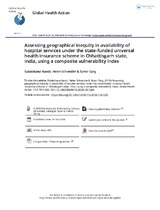| dc.identifier.citation | Sulakshana Nandi, Helen Schneider & Samir Garg (2018) Assessing geographical inequity in availability of hospital services under the state-funded universal health insurance scheme in Chhattisgarh state, India, using a composite vulnerability index, Global Health Action, 11:1, 1541220, DOI: 10.1080/16549716.2018.1541220 | en_US |
| dc.description.abstract | Background: Countries are increasingly adopting health insurance schemes for achieving
Universal Health Coverage. India’s state-funded health insurance scheme covers hospital care
provided by ‘empanelled’ private and public hospitals.
Objective: This paper assesses geographical equity in availability of hospital services under
the universal health insurance scheme in Chhattisgarh state.
Methods: The study makes use of district data from the insurance scheme and government
surveys. Selected socio-economic indicators are combined to form a composite vulnerability
index, which is used to rank and group the state’s 27 districts into tertiles, named as highest,
middle and lowest vulnerability districts (HVDs, MVDs, LVDs). Indicators of hospital service
availability under the scheme – insurance coverage, number of empanelled private/public
hospitals, numbers and amounts of claims – are compared across districts and tertiles. Two
measures of inequality, difference and ratio, are used to compare availability between tertiles.
Results: The study finds that there is a geographical pattern to vulnerability in Chhattisgarh
state. Vulnerability increases with distance from the state’s centre towards the periphery. The
highest vulnerability districts have the highest insurance coverage, but the lowest availability
of empanelled hospitals (3.4 hospitals per 100,000 enrolled in HVDs, vs 8.2/100,000 enrolled
in LVDs). While public sector hospitals are distributed equally, the distribution of private
hospitals across tertiles is highly unequal, with higher availability in LVDs. The number of
claims (per 100,000 enrolled) in the HVDs is 3.5-times less than that in the LVDs. The claim
amounts show a similar pattern.
Conclusions: Although insurance coverage is higher in the more vulnerable districts, availability
of hospital services is inversely proportional to vulnerability and, therefore, the need
for these services. Equitable enrolment in health insurance schemes does not automatically
translate into equitable access to healthcare, which is also dependent on availability and
specific dynamics of service provision under the scheme. | en_US |

